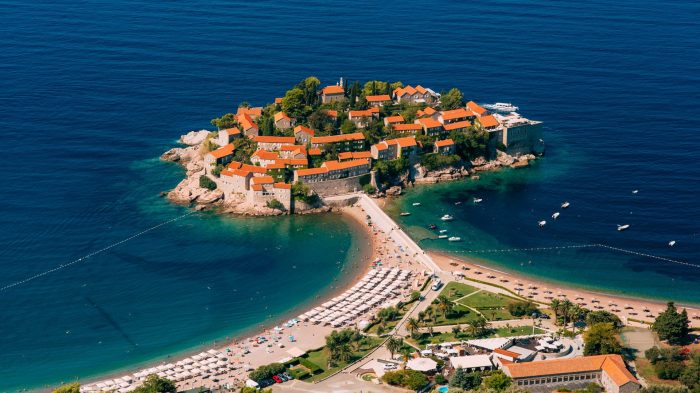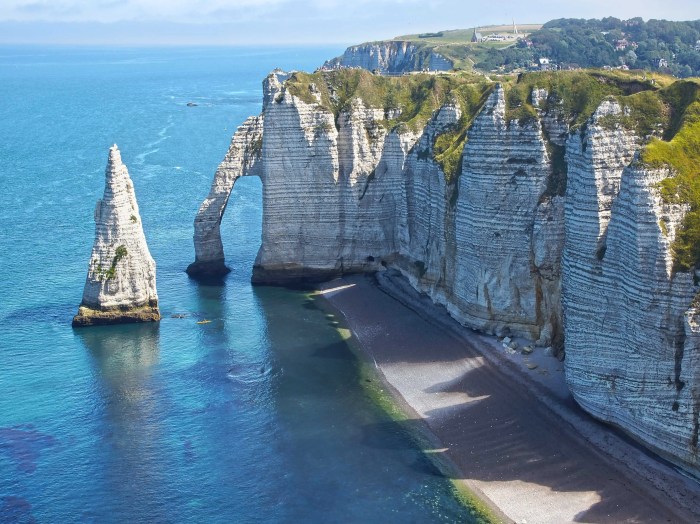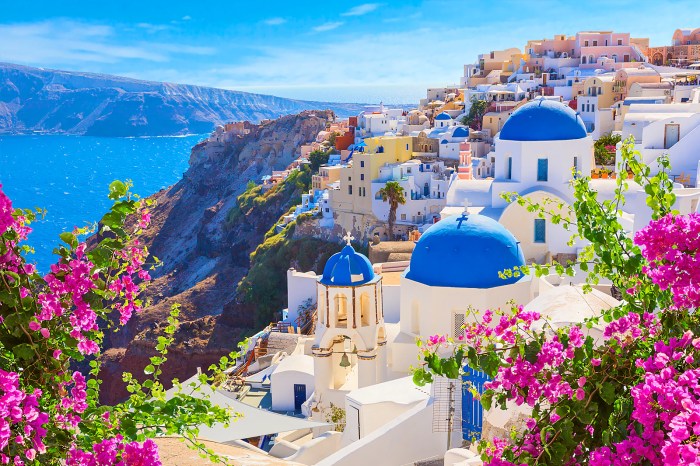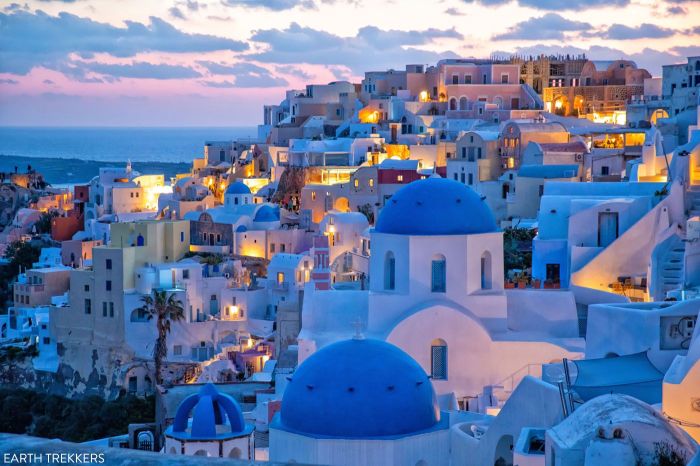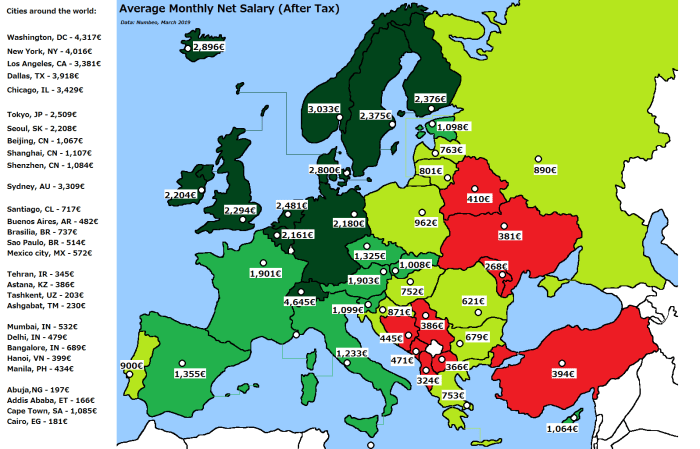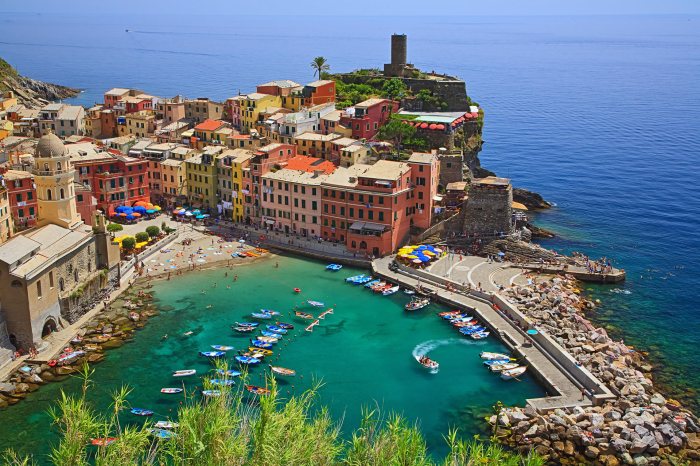Top 10 Places To Visit In Sicily
Top 10 Places To Visit in Sicily – the name itself conjures up images of ancient ruins, sun-drenched beaches, and mouthwatering cuisine. This island, a melting pot of cultures and a haven for adventure, offers something for everyone. From the dramatic cliffs of the coastline to the summit of Mount Etna, Sicily’s diverse landscapes and rich history will leave you breathless.
Imagine yourself strolling through the Valley of the Temples in Agrigento, marveling at the architectural prowess of the Greeks, or exploring the charming towns of Taormina and Syracuse, where history whispers at every corner. Then, picture yourself hiking through the volcanic landscapes of Mount Etna, the largest active volcano in Europe, or savoring the flavors of traditional Sicilian dishes, each a testament to the island’s culinary heritage.
Sicily is a tapestry of experiences, waiting to be unraveled.
The Enchanting Coastline
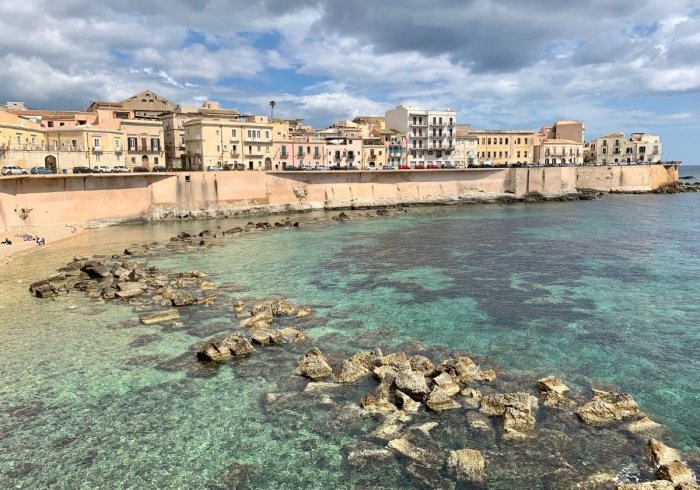
Sicily’s coastline is a masterpiece of nature, boasting an incredible array of landscapes that captivate the senses. From rugged cliffs that plunge into turquoise waters to golden sandy beaches that stretch for miles, the island offers a diverse and breathtaking coastal experience.
A Tapestry of Coastal Beauty
Sicily’s coastline is a tapestry of diverse landscapes, each with its unique charm. The northern coast features dramatic cliffs that rise majestically from the sea, offering stunning panoramic views. These cliffs are often adorned with ancient ruins, adding a touch of history to the natural beauty.
In contrast, the southern coast is characterized by long stretches of sandy beaches, perfect for sunbathing and swimming. The crystal-clear waters are ideal for snorkeling and diving, revealing a vibrant underwater world teeming with marine life.
Coastal Towns and Villages
Sicily’s coastline is dotted with charming towns and villages that offer breathtaking views and a taste of authentic Sicilian life.
- Taormina, perched on a cliff overlooking the Ionian Sea, is known for its stunning views of Mount Etna and its ancient Greek theater.
- Cefalù, with its picturesque harbor and Norman cathedral, is a popular destination for its beautiful beaches and historic center.
- Siracusa, a UNESCO World Heritage Site, boasts a rich history and a beautiful coastline with stunning beaches and the ancient Greek city of Ortygia.
- Agrigento, home to the Valley of the Temples, also has a charming coastal area with the beautiful beaches of the Lido di San Leone.
Ancient Wonders
Sicily is a land steeped in history, with ancient ruins that whisper tales of civilizations long gone. These remnants of the past offer a glimpse into the lives and cultures that shaped this island, making Sicily a haven for history buffs and anyone fascinated by the enduring legacy of ancient civilizations.
The Valley of the Temples
The Valley of the Temples in Agrigento is a UNESCO World Heritage Site that showcases the grandeur of ancient Greek architecture. This sprawling complex houses seven remarkably preserved temples, each dedicated to a different Greek deity. The Temple of Concordia, with its iconic Doric columns and intricate carvings, stands as a testament to the architectural prowess of the ancient Greeks.
The temple is a remarkable example of the Doric order, characterized by its simple, elegant design and the use of massive columns.
The Valley of the Temples is a unique and irreplaceable example of a Greek city of the 5th and 6th centuries BC, illustrating the influence of Greek culture in Sicily.
The Greek Theatre in Taormina
Perched high above the town of Taormina, the Greek Theatre offers breathtaking views of the Ionian Sea and Mount Etna. Built in the 3rd century BC, this amphitheater has been used for theatrical performances and cultural events for centuries. Its remarkable acoustics and the stunning backdrop of the surrounding landscape make it a truly unforgettable experience.
The theatre is a remarkable example of ancient Greek engineering and architectural ingenuity. The semi-circular shape of the theatre, with its tiered seating, allowed for a large audience to enjoy performances.
The Roman Amphitheatre in Syracuse
The Roman Amphitheatre in Syracuse, dating back to the 3rd century AD, is one of the largest and best-preserved Roman amphitheatres in the world. This imposing structure was once used for gladiatorial contests, public executions, and other forms of entertainment.
The amphitheatre’s size and the elaborate carvings on its walls reflect the power and sophistication of the Roman Empire.
The Roman Amphitheatre is a reminder of the vast influence of the Roman Empire on Sicily. The amphitheatre is a remarkable example of Roman engineering and architectural prowess.
Volcanic Landscapes
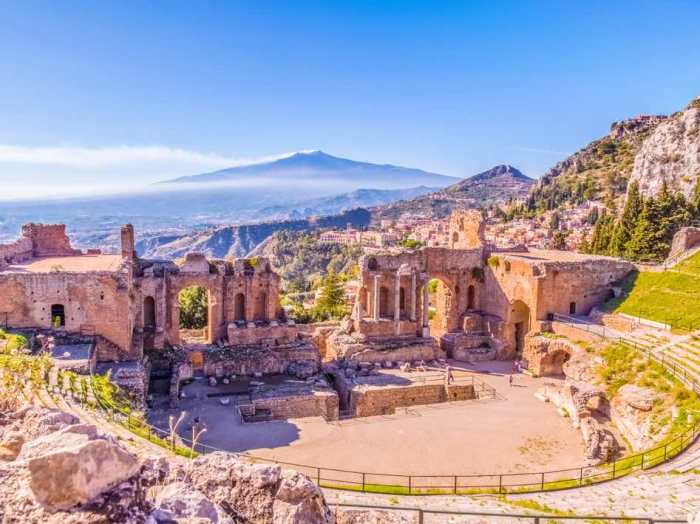
Sicily’s volcanic landscapes are a testament to the dynamic forces that have shaped the island over millennia. Mount Etna, Europe’s largest active volcano, dominates the eastern part of the island, its slopes a patchwork of black lava flows, verdant forests, and snow-capped peaks.
The presence of volcanoes has not only created dramatic landscapes but has also deeply influenced the island’s culture and agriculture.
Exploring Mount Etna
The volcanic activity of Mount Etna offers a unique and captivating experience for visitors. Hiking trails wind through the diverse landscapes, allowing visitors to witness the raw power of nature firsthand. The trails range in difficulty, catering to both experienced hikers and those seeking a more leisurely stroll.
The views from the summit are breathtaking, offering panoramic vistas of the surrounding countryside and the shimmering Mediterranean Sea.
Impact of Volcanic Activity
The volcanic soils surrounding Mount Etna are incredibly fertile, contributing to the island’s rich agricultural heritage. The volcanic ash and minerals provide essential nutrients for vineyards, citrus groves, and other crops. The region is renowned for its wines, especially the robust Etna Rosso, which is produced from grapes grown on the volcanic slopes.
The volcanic activity has also shaped the island’s cultural identity, with ancient myths and legends surrounding Mount Etna, often depicting it as a powerful and unpredictable deity.
Charming Towns and Villages: Top 10 Places To Visit In Sicily
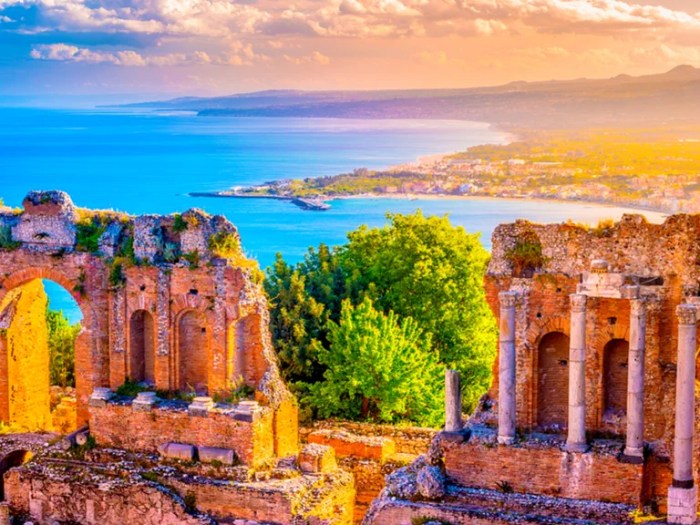
Sicily’s beauty extends beyond its stunning coastline and ancient ruins. Dotted across the island are charming towns and villages, each with its own unique character and history. These places offer a glimpse into the heart of Sicilian life, where time seems to move at a slower pace, and the warmth of local hospitality is palpable.
Exploring the Enchanting Villages of Sicily
These towns and villages are not just picturesque; they are vibrant centers of culture, tradition, and delicious cuisine. Each location boasts a rich history, often dating back to ancient times, reflected in their architecture, local customs, and even their food.
- Taormina:Perched on a cliff overlooking the Ionian Sea, Taormina is a breathtaking town known for its stunning views, ancient Greek theater, and charming cobblestone streets. Its strategic location has made it a popular destination throughout history, attracting everyone from ancient Greeks to Roman emperors.
The town’s unique blend of ancient and modern is evident in its architecture, with Roman ruins juxtaposed against colorful, flower-filled balconies. Taormina is also renowned for its vibrant nightlife, with numerous restaurants, bars, and shops lining its narrow streets.
- Cefalù:Located on the northern coast, Cefalù is a picturesque town with a rich history and stunning natural beauty. Its iconic Norman cathedral, perched on a hill overlooking the sea, is a testament to the town’s rich past. Cefalù is known for its beautiful beaches, clear waters, and delicious seafood.
The town’s charming streets are lined with shops selling local crafts, and its vibrant atmosphere is a perfect blend of history, culture, and natural beauty.
- Erice:Nestled high in the mountains, Erice is a medieval town that seems to be frozen in time. Its narrow, winding streets are lined with ancient buildings, including the Norman castle and the 14th-century Church of San Giuliano. Erice is known for its stunning views, its traditional sweets, and its relaxed atmosphere.
The town’s location provides breathtaking panoramas of the surrounding countryside, making it a popular destination for hikers and nature lovers.
- Siracusa:While not technically a village, Siracusa is a city with a distinct village-like charm. Known for its rich history and its beautiful baroque architecture, Siracusa is home to several ancient sites, including the Greek theater, the Roman amphitheater, and the island of Ortygia.
The city’s historic center is a maze of narrow streets lined with charming cafes, restaurants, and shops. The vibrant atmosphere of Siracusa is a perfect blend of ancient history and modern life, making it a unique and captivating destination.
- Monreale:Situated near Palermo, Monreale is known for its magnificent Norman cathedral, a UNESCO World Heritage Site. The cathedral’s interior is adorned with stunning mosaics that depict scenes from the Bible. Monreale is also home to a charming historic center, with narrow streets lined with shops and restaurants.
Sicily’s got it all: ancient ruins, charming villages, and beaches that would make you think you’re in the Caribbean. But when it comes to jaw-dropping natural beauty, it’s hard to top the volcanic Etna, which is on the list of Top 25 Natural Wonders Of The World.
If you’re looking for a place to lose yourself in the stunning scenery of a real-life “Wonder of the World,” Sicily’s got you covered.
The town’s peaceful atmosphere and its breathtaking views make it a perfect place to escape the hustle and bustle of city life.
Exploring the Unique Culture and Cuisine of Sicilian Villages
These charming towns and villages offer a unique window into the rich cultural tapestry of Sicily. Each location has its own traditions, festivals, and culinary delights.
- Taormina:The town is known for its vibrant nightlife and its delicious cuisine. Taormina is a popular destination for foodies, with a wide range of restaurants serving traditional Sicilian dishes. The town’s famous almond paste sweets are a must-try, as are the fresh seafood dishes.
- Cefalù:Cefalù is famous for its delicious seafood dishes, especially its fresh pasta with seafood sauces. The town’s traditional markets offer a wide variety of local produce, including fresh fish, vegetables, and cheeses.
- Erice:Erice is known for its traditional sweets, especially its almond paste pastries and its “genovese,” a type of sweet bread. The town’s charming cafes and restaurants offer a range of local delicacies, including its famous “panelle,” chickpea fritters.
- Siracusa:Siracusa is known for its rich culinary heritage, with dishes that reflect the town’s Greek and Roman influences. The city’s famous “arancini,” fried rice balls filled with various ingredients, are a must-try. Siracusa is also known for its fresh seafood dishes, especially its grilled swordfish.
- Monreale:Monreale is known for its traditional Sicilian cuisine, with dishes that are simple yet flavorful. The town’s famous “pasta alla norma,” a dish of pasta with tomato sauce, eggplant, and ricotta cheese, is a must-try. Monreale is also known for its delicious “cannoli,” crispy pastry shells filled with sweet ricotta cream.
Cultural Heritage
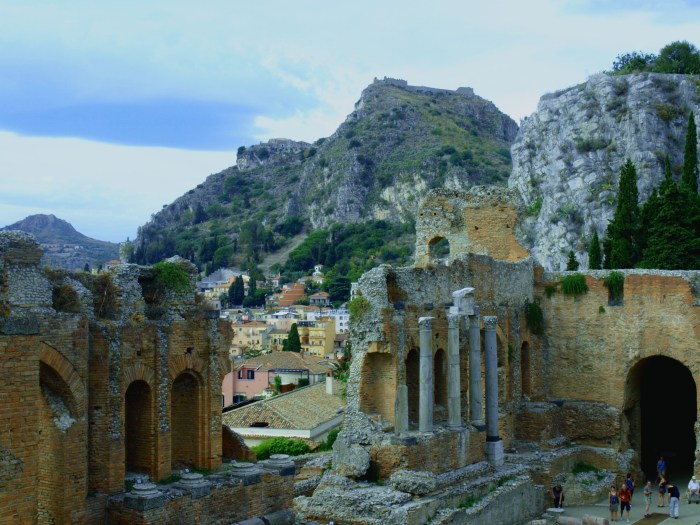
Sicily’s rich cultural heritage is a captivating blend of influences, a tapestry woven from the threads of ancient civilizations and historical events. The island has been a crossroads of cultures for millennia, each leaving its mark on the island’s art, music, literature, and traditions.
From the ancient Greeks to the Romans, Arabs, and Normans, each civilization has contributed to the unique cultural mosaic that defines Sicily today.
The Influence of Ancient Civilizations
Sicily’s cultural heritage is deeply rooted in its ancient past. The island was a center of Greek civilization for centuries, with cities like Syracuse and Agrigento becoming renowned for their architecture, philosophy, and art. The Greeks left behind a legacy of temples, theaters, and mosaics that still stand as testaments to their cultural influence.
The Romans, who conquered Sicily in the 3rd century BC, brought their own cultural influences, introducing Roman law, engineering, and architecture. Roman ruins, including the amphitheater in Taormina and the Villa del Casale in Piazza Armerina, are a reminder of this period.
The Arab Legacy
The Arab conquest of Sicily in the 9th century brought a new wave of cultural influences. The Arabs introduced new agricultural techniques, advanced medical practices, and a rich literary tradition. They also built mosques, palaces, and gardens, leaving behind a legacy of architectural beauty and cultural sophistication.
Sicily is a total vibe, with ancient ruins, stunning beaches, and delicious food. But if you’re looking for a more tropical getaway, you should check out Top Places and Things To Do in Bora Bora. While Bora Bora is a bit of a different scene, it’s also got a lot to offer, and after you’ve soaked up the sun and explored the island, you’ll be ready to hit up those Sicilian vineyards for some vino!
The Arab influence can still be seen in Sicilian cuisine, with dishes like couscous and almond pastries reflecting their culinary heritage.
Norman Rule and Beyond, Top 10 Places To Visit in Sicily
The Norman conquest of Sicily in the 11th century ushered in a new era of cultural development. The Normans, known for their military prowess and architectural skills, blended elements of Byzantine, Arab, and Roman styles to create a unique architectural style that is still evident in many Sicilian churches and castles.
The Norman period also saw the rise of a flourishing literary tradition, with writers like the poet Giacomo da Lentini contributing to the development of the Sicilian language and literature.
Museums and Galleries
Sicily is home to a wealth of museums and galleries that showcase its rich cultural heritage. The Archaeological Museum of Syracuse houses a collection of ancient Greek artifacts, including the famous “Dying Gaul” statue. The Regional Archaeological Museum Antonino Salinas in Palermo features a collection of ancient artifacts, including the “Venus of Palermo” statue.
The Galleria Regionale della Sicilia in Palermo showcases a collection of Sicilian paintings, sculptures, and decorative arts.
Cultural Events
Throughout the year, Sicily hosts a variety of cultural events that celebrate the island’s vibrant heritage. The Palermo Carnival, held in February, is a colorful celebration of music, dance, and costumes. The Taormina Film Festival, held in June, attracts international filmmakers and film enthusiasts.
The Siracusa Greek Theater Festival, held in July and August, features classical Greek plays performed in the ancient Greek theater.
Culinary Delights
Sicily’s vibrant culinary scene is as diverse and captivating as its landscapes. The island’s rich history, influenced by Greeks, Romans, Arabs, and Spaniards, has left an indelible mark on its cuisine, resulting in a symphony of flavors that will tantalize your taste buds.
Must-Try Sicilian Dishes
Sicilian cuisine is renowned for its fresh, seasonal ingredients and bold flavors. Here are some must-try dishes that encapsulate the essence of Sicilian culinary artistry:
- Arancini:These deep-fried rice balls are a Sicilian staple. They come in various fillings, including ragù, mozzarella, and peas, and are often served as an appetizer or street food. The crispy exterior contrasts beautifully with the soft, cheesy interior.
- Pasta alla Norma:This iconic dish features rigatoni pasta tossed in a rich tomato sauce, eggplant, ricotta salata, and basil. The combination of sweet, savory, and salty flavors creates a truly memorable experience.
- Caponata:This sweet and sour vegetable stew features eggplant, tomatoes, celery, onions, capers, and olives. It is often served as a side dish or antipasto and can be enjoyed hot or cold.
- Sfincione:This thick, rectangular pizza is a Sicilian specialty. It features a soft, yeasty dough topped with a tomato sauce, onions, anchovies, and oregano. The result is a unique and flavorful pizza that is unlike anything you’ve tasted before.
- Cannoli:These crispy, tube-shaped pastries are filled with a sweet ricotta cream and often dusted with powdered sugar. Cannoli are a quintessential Sicilian dessert and a must-try for any sweet tooth.
Regional Variations in Sicilian Cuisine
Sicilian cuisine is not a monolithic entity. Each region of the island boasts its own unique culinary traditions and specialties.
- Palermo:The capital city of Palermo is known for its street food, including arancin, sfincione, and panelle (chickpea fritters). Palermo also has a strong Arabic influence in its cuisine, with dishes like couscous and pastries filled with almond paste.
- Trapani:The western region of Trapani is known for its seafood, especially tuna. The area is also home to the famous “trapanese” couscous, a dish made with fish, vegetables, and a rich tomato sauce.
- Syracuse:The eastern region of Syracuse is known for its rich seafood tradition. Dishes like “spaghetti alle vongole” (spaghetti with clams) and “pesce spada alla siciliana” (swordfish with Sicilian flavors) are popular choices.
- Agrigento:The southern region of Agrigento is known for its “cucchi” (a type of pasta made with semolina flour) and its almond-based desserts.
Traditional Sicilian Dishes
| Dish | Description | Ingredients | Recommended Pairing |
|---|---|---|---|
| Arancini | Deep-fried rice balls with various fillings, including ragù, mozzarella, and peas. | Rice, meat sauce, mozzarella, peas, breadcrumbs, eggs | White wine, like a Sicilian Grillo or Catarratto |
| Pasta alla Norma | Rigatoni pasta tossed in a rich tomato sauce, eggplant, ricotta salata, and basil. | Rigatoni pasta, tomato sauce, eggplant, ricotta salata, basil | Red wine, like a Sicilian Nero d’Avola or Frappato |
| Caponata | Sweet and sour vegetable stew featuring eggplant, tomatoes, celery, onions, capers, and olives. | Eggplant, tomatoes, celery, onions, capers, olives, vinegar, sugar | White wine, like a Sicilian Inzolia or Chardonnay |
| Sfincione | Thick, rectangular pizza topped with a tomato sauce, onions, anchovies, and oregano. | Pizza dough, tomato sauce, onions, anchovies, oregano | Red wine, like a Sicilian Nerello Mascalese or Etna Rosso |
| Cannoli | Crispy, tube-shaped pastries filled with a sweet ricotta cream and often dusted with powdered sugar. | Pastry dough, ricotta cheese, sugar, chocolate chips | Sweet wine, like a Sicilian Moscato or Marsala |
Wine and Spirits
Sicily’s rich history and diverse landscape have nurtured a vibrant winemaking tradition that dates back to ancient times. The island boasts a wide array of grape varieties and terroirs, producing wines that are as unique and diverse as its culture.
From the sun-drenched slopes of Mount Etna to the rolling hills of the western coast, Sicily offers a journey for the senses, where each sip reveals the essence of this enchanting island.
Wine-Producing Regions
Sicily’s wine regions are renowned for their distinct characteristics, shaped by the interplay of climate, soil, and centuries-old winemaking techniques.
- Etna:This active volcano creates a unique terroir, with volcanic soils and a cool climate. Etna wines, primarily made with Nerello Mascalese and Carricante grapes, are known for their elegant structure, mineral notes, and vibrant acidity.
- Marsala:Located on the western coast, Marsala is famous for its fortified wine, made with Grillo and Catarratto grapes. The wine undergoes a long aging process in oak barrels, developing rich flavors of caramel, dried fruit, and nuts.
- Menfi:This region in the southwest is known for its production of fresh and aromatic white wines, particularly those made with Grillo and Inzolia grapes. The wines are often characterized by citrusy notes, floral aromas, and a crisp acidity.
- Siracusa:This region in the southeast is home to the Nero d’Avola grape, which produces full-bodied red wines with ripe fruit flavors, spicy notes, and a long finish. The region’s wines often pair well with hearty Sicilian dishes.
- Trapani:This region in the west is known for its production of sweet dessert wines, particularly those made with Moscato and Zibibbo grapes. The wines are often characterized by floral aromas, honeyed notes, and a refreshing acidity.
History and Production Methods
Sicilian winemaking has a long and rich history, dating back to the ancient Greeks and Romans. Over the centuries, the island’s winemaking traditions have evolved, blending ancient techniques with modern innovations.
- Ancient Roots:The island’s winemaking history can be traced back to the Phoenicians, who introduced grape cultivation to Sicily. The Greeks and Romans further developed wine production, establishing vineyards and exporting their wines throughout the Mediterranean.
- Modern Innovations:In recent decades, Sicilian winemakers have embraced modern techniques, such as the use of stainless steel tanks for fermentation and the introduction of new grape varieties. This has led to a resurgence in the quality and diversity of Sicilian wines.
- Distinctive Flavors and Aromas:Sicilian wines are known for their distinctive flavors and aromas, which are influenced by the island’s unique terroir and grape varieties. The wines often exhibit notes of citrus, herbs, spices, and ripe fruit, reflecting the Mediterranean climate and the volcanic soils of the island.
Sicily’s got everything – ancient ruins, charming villages, and seriously delicious food. If you’re looking for a similar vibe with a mountain twist, check out the Top 25 Places To Visit in Switzerland. You’ll find breathtaking scenery, cozy towns, and tons of outdoor adventure.
But hey, nothing beats a good slice of Sicilian pizza after a day of exploring, right?
Popular Sicilian Wines
Sicily offers a wide array of wines to suit every palate. Here are a few popular examples:
- Etna Rosso:This full-bodied red wine, made with Nerello Mascalese, is known for its elegant structure, mineral notes, and vibrant acidity. It pairs well with grilled meats, lamb, and pasta dishes with hearty sauces.
- Marsala:This fortified wine, made with Grillo and Catarratto grapes, is available in various styles, from dry to sweet. It is often enjoyed as an aperitif or paired with cheeses, desserts, and nuts.
- Cerasuolo di Vittoria:This full-bodied red wine, made with Nero d’Avola and Frappato grapes, is known for its ripe fruit flavors, spicy notes, and long finish. It pairs well with roasted meats, hearty stews, and cheeses.
- Grillo:This aromatic white grape produces crisp and refreshing wines with citrusy notes, floral aromas, and a clean finish. It pairs well with seafood, salads, and pasta dishes with light sauces.
- Moscato di Pantelleria:This sweet dessert wine, made with Zibibbo grapes, is known for its intense floral aromas, honeyed notes, and refreshing acidity. It pairs well with desserts, fruit tarts, and cheeses.
Island Adventures
Sicily’s allure extends beyond its mainland, with a collection of breathtaking islands offering a world of adventure and natural beauty. These island paradises are perfect for those seeking an escape from the mainland’s bustling crowds and a chance to explore a different side of Sicilian charm.
Exploring the Aeolian Islands
The Aeolian Islands, a UNESCO World Heritage Site, are a volcanic archipelago renowned for their dramatic landscapes and unique volcanic features. Each island boasts its own personality, offering a diverse range of experiences for every type of traveler.
- Hiking and Trekking:The islands are a hiker’s paradise, with trails winding through volcanic landscapes, past bubbling mud pools, and up to panoramic viewpoints. The iconic Mount Etna on the island of Vulcano offers challenging climbs with rewarding views of the surrounding islands and the Mediterranean Sea.
- Sailing and Boat Tours:The crystal-clear waters surrounding the Aeolian Islands are perfect for sailing and boat tours. Explore hidden coves, swim in turquoise waters, and witness the beauty of the islands from a unique perspective. Many tour operators offer day trips and multi-day excursions, allowing you to experience the islands at your own pace.
- Volcanic Wonders:The Aeolian Islands are a testament to the power of nature. Witness active volcanoes, explore volcanic craters, and experience the unique thermal springs that dot the islands. The island of Stromboli is famous for its frequent eruptions, offering a mesmerizing spectacle of fire and light.
The Egadi Islands: A Mediterranean Oasis
The Egadi Islands, located off the western coast of Sicily, are a tranquil escape from the mainland’s hustle and bustle. These islands are known for their pristine beaches, turquoise waters, and unspoiled natural beauty.
- Beaches and Snorkeling:The Egadi Islands are a haven for beach lovers and water sports enthusiasts. The islands boast some of the most beautiful beaches in Sicily, with soft white sand, crystal-clear waters, and secluded coves. The waters are ideal for snorkeling and diving, offering glimpses of colorful marine life.
- Wine and Food:The Egadi Islands are also known for their delicious cuisine and local wines. Sample fresh seafood, local cheeses, and artisanal wines produced on the islands. The island of Favignana is famous for its tuna fishing tradition, and you can enjoy freshly caught tuna in various dishes.
- Island Hopping:The Egadi Islands are easily accessible by ferry from Trapani on the mainland. Island hopping is a popular activity, allowing you to explore each island’s unique character and beauty. The islands of Favignana, Levanzo, and Marettimo offer diverse landscapes and experiences, from bustling port towns to secluded beaches.
Festivals and Events
Sicily is a place where history, culture, and tradition come alive through vibrant festivals and events that take place throughout the year. From religious processions to lively street parties, these celebrations offer a unique glimpse into the island’s rich heritage and captivating spirit.
The Feast of Santa Rosalia
The Feast of Santa Rosalia, celebrated in Palermo in July, is a grand spectacle that draws thousands of devotees and visitors. It commemorates the patron saint of Palermo, Santa Rosalia, whose remains were discovered in 1624 during a plague epidemic.
The festival features a massive procession with a gilded carriage carrying the saint’s statue, accompanied by music, fireworks, and dancing. The procession winds its way through the city’s historic streets, culminating in a spectacular display of light and sound. The Feast of Santa Rosalia is a testament to the deep religious faith of the Sicilian people and their unwavering devotion to their patron saint.
Other Notable Festivals
- The Feast of San Calogeroin Agrigento, held in June, is a colorful celebration that honors the patron saint of the city. It features traditional dances, music, and a procession with a statue of the saint. The highlight of the festival is the “Saltatura di San Calogero,” a ritual dance performed by a group of men who jump over a bonfire.
This ritual is believed to bring good luck and ward off evil spirits.
- The Feast of the Madonna della Catenain Messina, celebrated in August, is a grand procession that honors the Virgin Mary. It features a magnificent statue of the Madonna, adorned with jewels and flowers, carried through the city’s streets on a massive float. The procession is accompanied by music, fireworks, and prayers.
The festival is a testament to the strong Catholic faith of the people of Messina and their devotion to the Virgin Mary.
- The Feast of San Vitoin Modica, held in June, is a lively celebration that honors the patron saint of the city. It features a procession with a statue of the saint, accompanied by music, dancing, and fireworks. The highlight of the festival is the “Sagra di San Vito,” a traditional feast that features local delicacies, such as pastries and sweets.
This festival is a great opportunity to experience the vibrant culture and culinary traditions of Modica.
- The Feast of San Giuseppein Catania, celebrated in March, is a unique festival that honors the patron saint of the city. It features a procession with a statue of the saint, accompanied by music, dancing, and fireworks. The highlight of the festival is the “Festa di San Giuseppe,” a traditional feast that features a special kind of pastry called “Sfincione,” a bread topped with tomato sauce, cheese, and anchovies.
This festival is a great opportunity to experience the rich culinary traditions of Catania.
Getting Around
Sicily’s diverse landscapes and numerous attractions make it an exciting place to explore. To maximize your time and truly experience the island’s charm, choosing the right mode of transportation is crucial. From scenic drives to convenient public transport options, there’s a way to get around that suits every travel style.
Car Rentals
Renting a car offers the ultimate freedom to explore Sicily at your own pace. You can easily navigate the island’s winding roads, discover hidden gems, and enjoy breathtaking views. However, driving in Sicily can be challenging due to narrow roads, traffic, and potential language barriers.
- It’s essential to be comfortable with manual transmission, as automatic cars are less common.
- Be prepared for tolls on major highways, and familiarize yourself with local driving rules and regulations.
- Consider renting a car with a GPS system to navigate unfamiliar routes.
Public Transport
Sicily’s public transport system is extensive and affordable, connecting major cities and towns.
- Trains are a reliable option for long-distance travel, offering scenic views and comfortable seating.
- Buses are a more frequent and affordable alternative, particularly for shorter journeys within cities and towns.
- Intercity buses are also available for traveling between different regions.
Ferries
Ferries are an essential mode of transportation for reaching Sicily’s islands, including the Aeolian Islands, the Egadi Islands, and Pantelleria.
- Ferries are a convenient way to experience the stunning coastline and enjoy breathtaking views.
- Hydrofoils offer faster travel times but are generally more expensive than traditional ferries.
- Ferries are also a popular option for traveling between mainland Italy and Sicily.
Tips for Navigating Sicily
- Plan your routes in advance, especially during peak season, to avoid delays and traffic.
- Purchase tickets for public transport in advance, particularly for trains and intercity buses.
- Learn basic Italian phrases to communicate with locals and navigate public transport.
- Consider using ride-sharing services or taxis for shorter distances, especially in urban areas.
- Be aware of potential scams and be cautious when dealing with unofficial transportation providers.
Reaching Popular Destinations
- Palermo: The capital city is easily accessible by air, with Palermo Airport (PMO) offering direct flights from major European cities. Alternatively, you can take a train from mainland Italy.
- Taormina: Located on the eastern coast, Taormina is best reached by car or by bus from Catania, the nearest major city.
- Mount Etna: You can reach Mount Etna by car, bus, or guided tour. There are several hiking trails and cable car options for exploring the volcano.
- Syracuse: Located on the southeastern coast, Syracuse is accessible by train from Palermo or Catania. You can also reach the city by bus from other parts of Sicily.
- Agrigento: This historic city is best reached by car or by bus from Palermo or Catania.
Conclusive Thoughts
So, whether you’re seeking a relaxing beach getaway, a cultural immersion, or an adventurous escape, Sicily has it all. With its breathtaking scenery, captivating history, and warm hospitality, this island promises an unforgettable experience. So, pack your bags, grab your camera, and get ready to explore the magic of Sicily!
FAQ Compilation
Is Sicily safe for tourists?
Sicily is generally a safe destination for tourists. However, as with any travel destination, it’s important to be aware of your surroundings and take common-sense precautions.
What is the best time to visit Sicily?
The best time to visit Sicily depends on your preferences. Spring (April-May) and autumn (September-October) offer pleasant weather and fewer crowds. Summer (June-August) is hot and sunny, ideal for beach lovers. Winter (November-March) is mild but can be rainy.
What is the currency used in Sicily?
The currency used in Sicily is the Euro (EUR).
What language is spoken in Sicily?
The official language of Sicily is Italian. However, a regional dialect known as Sicilian is also widely spoken.

